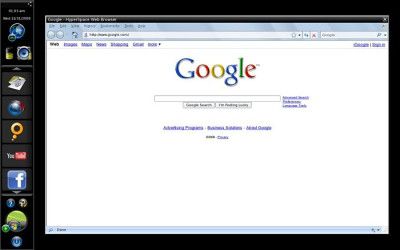From our front-page news:
As last week's Intel Developer Forum, I had the opportunity to chat to Phoenix (the BIOS makers) about both their "Instant-On" technology, and also their quick-boot HyperSpace OS. Since I've had a keen interest in competing technologies for a while, such as DeviceVM's SplashTop, I couldn't help but want to take HyperSpace for a spin. Is it better? In the short amount of time I had to spend with it, yes, it goes without saying.
To be fair to DeviceVM, though, it's been quite a while since I've been able to take SplashTop for a spin (at least a year), but there's one thing Phoenix has that everyone else will have a hard time to compete with... the development rights to the BIOS. Because Phoenix produces both this software and the system BIOS, their solution has the ability to be much faster than anything else out there. The company assured me that competitors also have access to key features in the BIOS as well though, so as to avoid a monopoly.
The other benefit of HyperSpace is that it's not exclusive to one notebook, because you are able to download the program yourself (it carries a fee past the trial), and then install it to your notebook to see if it works. If it does, you'll be able to access the HyperSpace desktop just as you would on a notebook that came with the software pre-installed. As for functionality... you won't have to worry there. Currently, there is support for light gaming (think Web games), the Internet, video and image viewing, DVD playback and even the ability to edit office documents. It's definitely the most robust instant-on OS I've seen to date.
HyperSpace comes in two editions... Dual and Hybrid. You'll require Intel's VT for Hybrid to work, as HyperSpace will require virtualization access to the CPU. What makes it cool, though, is that you can switch between both Windows and HyperSpace very quickly. If you are in Windows, you simply double-click the icon on the desktop, wait about 8 seconds, and then you'll be right back into HyperSpace, where battery-life is far improved (so I'm told). To get back, you can click the Windows icon, and 3 - 4 seconds later, you'll be right back at your Windows desktop. For the Dual version, you can only run one OS at a time.
I'm currently working towards getting a notebook equipped with HyperSpace in, because I'm really interested in seeing just how it compares to SplashTop as a whole, and what benefits it offers. If you've ever scoffed at the idea of an instant-on OS, HyperSpace may just change your mind.

HyperSpace lets you access the Web without having to wait for Windows to boot up. Power your computer and instantly surf the Internet, check e-mail or watch the YouTube video of the day. And when you want to switch off, just close the lid and off you go. But HyperSpace is much more than just instant-on. Perform your Web-based activities in HyperSpace to preserve precious battery life. You can use your notebook up to 30% longer if you compute in the HyperSpace section and use Windows only when absolutely necessary.
Source: Phoenix HyperSpace
To be fair to DeviceVM, though, it's been quite a while since I've been able to take SplashTop for a spin (at least a year), but there's one thing Phoenix has that everyone else will have a hard time to compete with... the development rights to the BIOS. Because Phoenix produces both this software and the system BIOS, their solution has the ability to be much faster than anything else out there. The company assured me that competitors also have access to key features in the BIOS as well though, so as to avoid a monopoly.
The other benefit of HyperSpace is that it's not exclusive to one notebook, because you are able to download the program yourself (it carries a fee past the trial), and then install it to your notebook to see if it works. If it does, you'll be able to access the HyperSpace desktop just as you would on a notebook that came with the software pre-installed. As for functionality... you won't have to worry there. Currently, there is support for light gaming (think Web games), the Internet, video and image viewing, DVD playback and even the ability to edit office documents. It's definitely the most robust instant-on OS I've seen to date.
HyperSpace comes in two editions... Dual and Hybrid. You'll require Intel's VT for Hybrid to work, as HyperSpace will require virtualization access to the CPU. What makes it cool, though, is that you can switch between both Windows and HyperSpace very quickly. If you are in Windows, you simply double-click the icon on the desktop, wait about 8 seconds, and then you'll be right back into HyperSpace, where battery-life is far improved (so I'm told). To get back, you can click the Windows icon, and 3 - 4 seconds later, you'll be right back at your Windows desktop. For the Dual version, you can only run one OS at a time.
I'm currently working towards getting a notebook equipped with HyperSpace in, because I'm really interested in seeing just how it compares to SplashTop as a whole, and what benefits it offers. If you've ever scoffed at the idea of an instant-on OS, HyperSpace may just change your mind.

HyperSpace lets you access the Web without having to wait for Windows to boot up. Power your computer and instantly surf the Internet, check e-mail or watch the YouTube video of the day. And when you want to switch off, just close the lid and off you go. But HyperSpace is much more than just instant-on. Perform your Web-based activities in HyperSpace to preserve precious battery life. You can use your notebook up to 30% longer if you compute in the HyperSpace section and use Windows only when absolutely necessary.
Source: Phoenix HyperSpace
